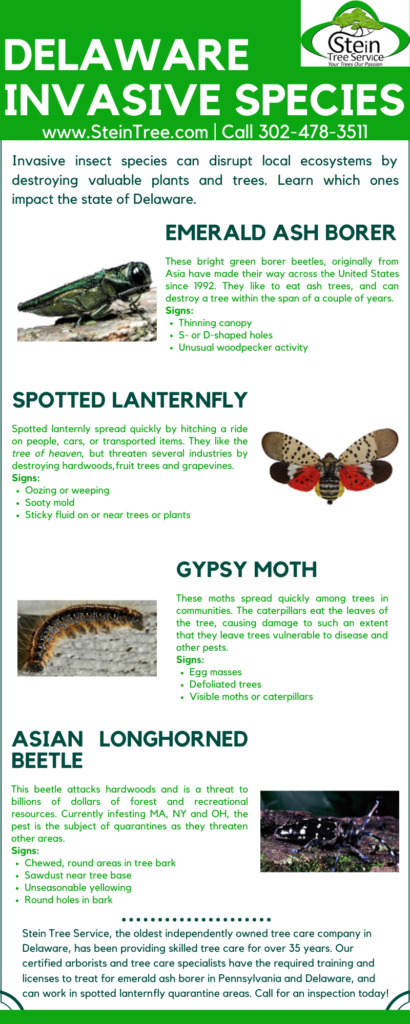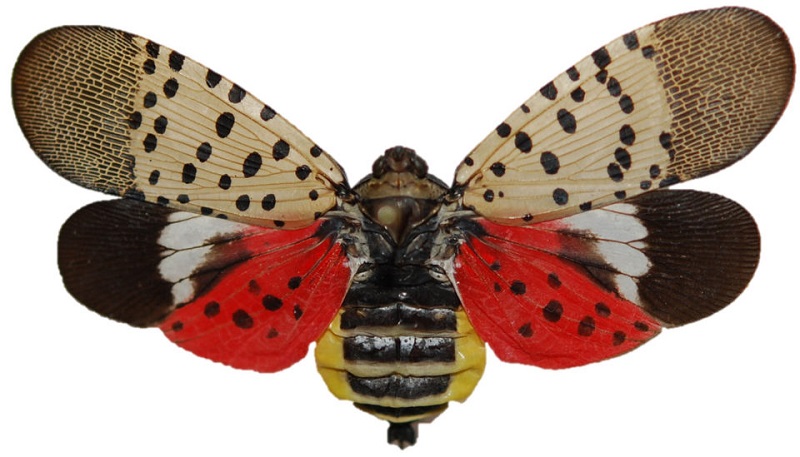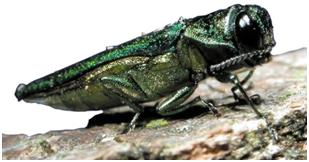Stein Discusses Invasive Species in Delaware


One threat that the Delaware environment faces is damage by invasive species. An invasive species is a non-native plant, insect or animal that is introduced into a region and causes some harm. That harm can affect plants or humans, and the damage can be economic or environmental. Many people have likely heard of some invasive species in their regions, but may be unaware of the harm caused by these species. Stein discusses a few of the invasive species in Delaware.
Invasive Species in Delaware
An invasive species can be found anywhere in an environment: bugs, fish, and even plants can be invasive species. Despite being non-native in an area, invasive species have many characteristics that allow them to thrive in the new environment. Rapid growth and maturity, the ability to produce a large number of offspring, and having few natural predators all enable invasive species to become big threats to the local ecosystem.
The invasive insects currently threatening harm to Delaware landscapes include the following:
- Red Imported Fire Ant
- Spotted Lanternfly
- Emerald Ash Borer
- Asian Longhorned Beetle
- Gypsy Moth
Red Imported Fire Ants
Red imported fire ants can attack and cause painful stings on humans, pets, and livestock. They are not typically found jn Delaware, but several incidents have occurred in recent years where the pest was carried in with shipments to the area.
Spotted Lanternfly

Spotted Lanternfly is one of the most well-known invasive species in Delaware. They spread easily by catching a ride on people, vehicles or equipment that is transported from one area to another. Spotted lanternflies attack the tree of heaven primarily, but are also particularly dangerous to industries such as timber, fruit trees, and grapes.
Emerald Ash Borer

The emerald ash borer has been spreading across the country and destroying ash trees since 1992. They were first found in Delaware in 2015 and though practices have been put into place to avoid the spread, they continue to be a threat. Federal quarantines are currently in place to help prevent the spread, and some tree care companies, such as Stein Tree Service, are licensed to treat for them as well.
Asian Longhorned Beetle
Similar to the emerald ash borer, the Asian longhorned beetle is another destructive wood-boring pest, although this beetle feeds on maple and other hardwoods rather than ash. Some states have quarantines on the movement of firewood and other items to help control the spread of this invasive beetle.
Gypsy Moth

Gypsy moths damage the leaves of a tree, and the caterpillars can even cause a poison ivy-like rash when they come into contact with humans. These moths spread quickly and easily from tree to tree, and can defoliate many in a single season. This type of extreme defoliation leaves the trees vulnerable to disease, pests or other environmental factors. A federal quarantine is in effect to help control the spread of gypsy moths.
Why Are Invasive Species A Problem?
While only some introduced species of plants or animals cause issues, the ones that do are a severe threat to the well-being of the environment. First, invasive species in Delaware reduce native diversity by competing for resources, such as space, sunlight, water, and food. An invasive species can inhibit the growth of other species, which on a bigger scale, can impact every part of an ecosystem. An area’s pollinators are dependent on plants that are normally readily available. If those plants become unavailable, the pollination process is disrupted, because those insects will have to go elsewhere to find the plants. The lack of those native insects will cause the birds and other animals who depend on them for nutrition will also have to go elsewhere. The impacts of non-native invasive species are far-reaching. Economically, invasive species can damage agricultural, forestry, and fishing industries, and may even reduce property values for some homes.
How to Spot an Invasive Species
Being vigilant about the presence of harmful insect species can help tree specialists and pest management specialists better identify affected areas and find solutions to preserve your landscape. Some symptoms of the emerald ash borer, for instance, include:
- D-shaped holes in bark
- Excessive woodpecker activity
- Galleries under the bark
- Epicormic sprouting
- Crown thinning
One method of fighting back against possible invasive species is to incorporate plants and trees that are native and resistant to invasive species in your landscape. If you find any symptoms of these invasive species, you should contact an arborist who is certified to treat for them.
Call Stein for Pest Management and other Tree Care Services
If you suspect that destructive insects are infesting your trees, contact Stein Tree Service. We are licensed to treat invasive species in Delaware, like the emerald ash borer and we are certified to perform plant and tree care services in areas of spotted lanternfly quarantine. We have been in business since 1983, and our experienced staff strives to provides exceptional tree care services. Contact us today for a free consultation.
CALL US
610.723.8072
Serving DE and PA
REQUEST A FREE, NO OBLIGATION CONSULTATION
FEATURED PROGRAMS
Stein Tree Earns Permit to Work in Spotted Lanternfly Quarantine Areas
Stein has a permit to work in spotted lanternfly quarantine areas in Pennsylvania and Delaware. Tree Service Companies have to be trained in proper moving and disposal of materials to avoid spread of the spotted lanternfly and Stein has completed the training courses. Learn more.
Emerald Ash Borer Inspection
In the spring, destructive emerald ash bore![]() r (EAB) adult beetles begin to emerge. These invasive pests can destroy your ash trees. Our specialists are certified to treat for EAB in Pennsylvania and Delaware. For a free consultation, contact us today.
r (EAB) adult beetles begin to emerge. These invasive pests can destroy your ash trees. Our specialists are certified to treat for EAB in Pennsylvania and Delaware. For a free consultation, contact us today.
